|
|
|
Sort Order |
|
|
|
Items / Page
|
|
|
|
|
|
|
| Srl | Item |
| 1 |
ID:
123884
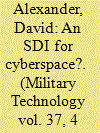

|
|
|
|
|
| Publication |
2013.
|
| Summary/Abstract |
In this article, the author discusses strategic defense initiative for cyberspace citing reference to an address delivered by U.S. President Barack Obama who warned people of consequences of cyber-attacks. Also discussed is an announcement made by the cyber security company Mandiant Corp. accusing China of a sponsored campaigns of cyber-espionage.
|
|
|
|
|
|
|
|
|
|
|
|
|
|
|
|
| 2 |
ID:
137896
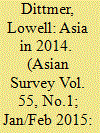

|
|
|
|
|
| Summary/Abstract |
THOUGH SOME MAY HAVE APPROACHED the centenary of the outbreak of World War One with a certain superstitious foreboding, 2014 in Asia was a pretty good year. As Xi Jinping put it in his May 21 address to the CICA (Conference on Interaction and Confidence Building Measures in Asia), ‘‘Asia today, though facing more risks and challenges, is still the most dynamic and promising region in the world.’’1 Economically, Asia remains the fastest growing region, averaging an estimated 6.1% GDP growth for the year, and the forecasting consensus predicts an even better next year. This is an impressive performance in the wake of the global 2009–13 slowdown and particularly the recent cooling of the Chinese locomotive. Politically, the headline for the year is democratic resilience, with relatively honest elections in Afghanistan, India, Bangladesh, Indonesia, and (jumping a few days into 2015) Sri Lanka. As for international security, on the other hand, it was a year of rising tensions: violent terrorist attacks in Afghanistan, Pakistan, Burma/Myanmar, India’s Assam, China’s Xinjiang; continuing confrontations over maritime boundaries in the South and East China Seas; and renewed fighting between India and Pakistan over Kashmir.
|
|
|
|
|
|
|
|
|
|
|
|
|
|
|
|
| 3 |
ID:
069465


|
|
|
|
|
| Publication |
Hershey, Idea publishing, 2006.
|
| Description |
xvii, 172p.
|
| Standard Number |
1599040212
|
|
|
|
|
|
|
|
|
|
|
|
Copies: C:1/I:0,R:0,Q:0
Circulation
| Accession# | Call# | Current Location | Status | Policy | Location |
| 051124 | 363.325/COL 051124 | Main | On Shelf | General | |
|
|
|
|
| 4 |
ID:
075274


|
|
|
| 5 |
ID:
060660


|
|
|
|
|
| Publication |
Mar-Apr 2005.
|
| Summary/Abstract |
Cyberterrorism conjures up images of vicious terrorists unleashing catastrophic attacks against computer networks, wreaking havoc, and paralyzing nations. This is a frightening scenario, but how likely is it to occur? Could terrorists cripple critical military, financial, and service computer systems? This article charts the rise of cyberangst and examines the evidence cited by those who predict imminent catastrophe. Psychological, political, and economic forces have combined to promote the fear of cyberterrorism. From a psychological perspective, two of the greatest fears of modern time are combined in the term “cyberterrorism.” The fear of random, violent victimization segues well with the distrust and outright fear of computer technology. Many of these fears, the report contends, are exaggerated: not a single case of cyberterrorism has yet been recorded, hackers are regularly mistaken for terrorists, and cyberdefenses are more robust than is commonly supposed. Even so, the potential threat is undeniable and seems likely to increase, making it all the more important to address the danger without inflating or manipulating it.
|
|
|
|
|
|
|
|
|
|
|
|
|
|
|
|
| 6 |
ID:
132231
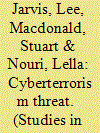

|
|
|
|
|
| Publication |
2014.
|
| Summary/Abstract |
This article reports on a recent research project exploring academic perspectives on the threat posed by cyberterrorism. The project employed a survey method, which returned 118 responses from researchers working across 24 different countries. The article begins with a brief review of existing literature on this topic, distinguishing between those concerned by an imminent threat of cyberterrorism, and other, more skeptical, views. Following a discussion on method, the article's analysis section then details findings from three research questions: (1) Does cyberterrorism constitute a significant threat? If so, against whom or what?; (2) Has a cyberterrorism attack ever taken place?; and (3) What are the most effective countermeasures against cyberterrorism? Are there significant differences to more traditional forms of anti- or counterterrorism? The article concludes by reflecting on areas of continuity and discontinuity between academic debate on cyberterrorism and on terrorism more broadly.
|
|
|
|
|
|
|
|
|
|
|
|
|
|
|
|
| 7 |
ID:
188761


|
|
|
|
|
| Summary/Abstract |
This article reports on a survey of researchers designed to capture current perspectives on core questions around cyberterrorism. The survey—conducted in 2017 as a follow-on to an initial, 2012, exercise—focused on questions of definition, threat and response. By documenting our findings in each of these areas—and highlighting developments in the years between our surveys—we identify three particularly important trends. First, an increasing convergence around the core characteristics of cyberterrorism, albeit with continuing conceptual disagreements at the concept’s penumbra. Second, increasing researcher concern with the threat posed by cyberterrorism, underpinned by a widespread view that this threat has increased, and a growing feeling that cyberterrorist attacks have now taken place. Third, support for a diversity of counter-measures to this threat, although perhaps counter-intuitively little suggestion that resort to exceptional or draconian measures is needed. In order to inform future research, the article concludes by detailing some of the major limitations, gaps and weaknesses within academic research to date as identified by our respondents.
|
|
|
|
|
|
|
|
|
|
|
|
|
|
|
|
| 8 |
ID:
178932
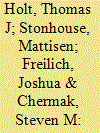

|
|
|
|
|
| Summary/Abstract |
Over the last two decades, there has been a massive increase in research examining terror and extremist-related violence. Few have considered the extent to which these same groups may engage in attacks against digital infrastructure and the Internet, whether through hacking or other methods. The absence of empirical evidence calls to question the nature and dynamics of cyberattacks performed by extremists and ideologically motivated actors. This study attempted to address this gap in the literature through a qualitative investigation of 26 attacks performed by far-left groups against targets in the UK, US, and Canada from 2000 to 2015. This data was compared to physical attacks documented in the Extremist Crime Database during the same period. The findings demonstrated that there was an increase in cyberattacks during a period of decreased physical violence by far-left groups. Additionally, there was some parity in the targets of far-left groups on- and off-line, with similar motivations to cause harm to or embarrass businesses, government organizations, and individuals. The implications of this study for our understanding of terror and future research were discussed in detail.
|
|
|
|
|
|
|
|
|
|
|
|
|
|
|
|
| 9 |
ID:
115540


|
|
|
|
|
| Publication |
Oxon, Routledge, 2007.
|
| Description |
xx,230p.
|
| Standard Number |
0415401852
|
|
|
|
|
|
|
|
|
|
|
|
Copies: C:1/I:0,R:0,Q:0
Circulation
| Accession# | Call# | Current Location | Status | Policy | Location |
| 056876 | 327.10254678/ERI 056876 | Main | On Shelf | General | |
|
|
|
|
| 10 |
ID:
077651


|
|
|
|
|
| Publication |
London, Routledge, 2007.
|
| Description |
xx, 230p.
|
| Series |
Routledge advances in international relations and global politics
|
| Standard Number |
9780415401852
|
|
|
|
|
|
|
|
|
|
|
|
Copies: C:1/I:0,R:0,Q:0
Circulation
| Accession# | Call# | Current Location | Status | Policy | Location |
| 052350 | 327.102854678/ERI 052350 | Main | On Shelf | General | |
|
|
|
|
| 11 |
ID:
094831


|
|
|
|
|
| Publication |
2010.
|
| Summary/Abstract |
The Internet has become a crucial part of modern society's life due to its ability to facilitate communication and structure contemporary society. Indonesia has not been left out of this global phenomenon. The Internet came to Indonesia in 1983 and its usage has continued to expand ever since, especially within institutions of learning and in the government sector. The study of radical websites must be situated within the development of the Internet in Indonesia in general instead of being examined by itself. The impact of certain activities such as cyberterrorism must then be examined in perspective, given the vast expanse of Indonesia as an archipelago and the resulting difficulties in linking the entire country to the Internet. This article seeks to trace the development of the Internet in Indonesia and examine the resulting impact on the reach of the radical Bahasa Indonesia Islamic websites in the Indonesian Archipelago and beyond. It also highlights typical narrative and operations of the radical websites, which serves to distinguish them from radical websites from elsewhere, such as the Middle East.
|
|
|
|
|
|
|
|
|
|
|
|
|
|
|
|
| 12 |
ID:
151976
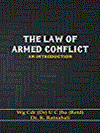

|
|
|
|
|
| Publication |
New Delhi, Vij Books India Pvt Ltd, 2017.
|
| Description |
xvi, 602p.hbk
|
| Standard Number |
9789385563904
|
|
|
|
|
|
|
|
|
|
|
|
Copies: C:1/I:0,R:0,Q:0
Circulation
| Accession# | Call# | Current Location | Status | Policy | Location |
| 058988 | 341.6/JHA 058988 | Main | On Shelf | General | |
|
|
|
|
| 13 |
ID:
068054
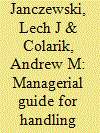

|
|
|
|
|
| Publication |
Hershey, Idea Group Publishing, 2005.
|
| Description |
xiv, 229p.Hbk
|
| Standard Number |
1591405831
|
|
|
|
|
|
|
|
|
|
|
|
Copies: C:1/I:0,R:0,Q:0
Circulation
| Accession# | Call# | Current Location | Status | Policy | Location |
| 050939 | 658.478/JAN 050939 | Main | On Shelf | General | |
|
|
|
|
| 14 |
ID:
069315


|
|
|
|
|
| Publication |
Santa Monica, Rand Corporation, 2001.
|
| Description |
xiv, 374p.
|
| Standard Number |
0833030302
|
|
|
|
|
|
|
|
|
|
|
|
Copies: C:1/I:0,R:0,Q:0
Circulation
| Accession# | Call# | Current Location | Status | Policy | Location |
| 045231 | 303.625/ARQ 045231 | Main | On Shelf | General | |
|
|
|
|
| 15 |
ID:
081922
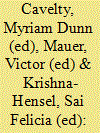

|
|
|
|
|
| Publication |
Hampshire, Ashgate Publishing Limited, 2007.
|
| Description |
xiv, 165p.
|
| Standard Number |
9780754670889
|
|
|
|
|
|
|
|
|
|
|
|
Copies: C:1/I:0,R:0,Q:0
Circulation
| Accession# | Call# | Current Location | Status | Policy | Location |
| 053558 | 005.8/CAV 053558 | Main | On Shelf | General | |
|
|
|
|
| 16 |
ID:
123094
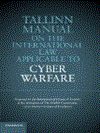

|
|
|
|
|
| Publication |
Cambridge, Cambridge University Press, 2013.
|
| Description |
xix, 282p.Pbk
|
| Standard Number |
9781107613775
|
|
|
|
|
|
|
|
|
|
|
|
Copies: C:1/I:0,R:0,Q:0
Circulation
| Accession# | Call# | Current Location | Status | Policy | Location |
| 057413 | 341.63/SCH 057413 | Main | On Shelf | General | |
|
|
|
|
| 17 |
ID:
151571


|
|
|
|
|
| Summary/Abstract |
This article explores original empirical findings from a research project investigating representations of cyberterrorism in the international news media. Drawing on a sample of 535 items published by 31 outlets between 2008 and 2013, it focuses on four questions. First, how individuated a presence is cyberterrorism given within news media coverage? Second, how significant a threat is cyberterrorism deemed to pose? Third, how is the identity of ‘cyberterrorists’ portrayed? And, fourth, who or what is identified as the referent – that which is threatened – within this coverage? The article argues that constructions of specificity, status, and scale play an important, yet hitherto under-explored, role within articulations of concern about the threat posed by cyberterrorism. Moreover, unpacking news coverage of cyberterrorism in this way leads to a more variegated picture than that of the vague and hyperbolic media discourse often identified by critics. The article concludes by pointing to several promising future research agendas to build on this work.
|
|
|
|
|
|
|
|
|
|
|
|
|
|
|
|
| 18 |
ID:
023125
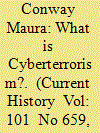

|
|
|
|
|
| Publication |
Dec 2002.
|
| Description |
436-442
|
|
|
|
|
|
|
|
|
|
|
|
|
|
|
|
| 19 |
ID:
140866
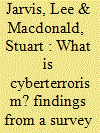

|
|
|
|
|
| Summary/Abstract |
This article reports on a recent survey designed to capture understandings of cyberterrorism across the global research community. Specifically, it explores competing views, and the importance thereof, amongst 118 respondents on three definitional issues: (a) the need for a specific definition of cyberterrorism for either policymakers or researchers; (b) the core characteristics or constituent parts of this concept; and (c) the value of applying the term “cyberterrorism” to a range of actual or potential scenarios. The article concludes by arguing that while a majority of researchers believe a specific definition of cyberterrorism is necessary for academics and policymakers, disagreement around what this might look like has additional potential to stimulate a rethinking of terrorism more widely.
|
|
|
|
|
|
|
|
|
|
|
|
|
|
|
|
|
|
|
|
|